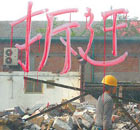Editorials
Build up our heritage
(China Daily)
Updated: 2010-01-25 07:54
 |
Large Medium Small |
A cemetery of Red Guards in the city of Chongqing was designated a historical site under local government protection last month. It is the only historical site of its kind in the country and will not only serve as a reminder of the terrible 10 years of the "cultural revolution" (1966 -76), it will mark a milestone in our perception of cultural heritage.
The most disastrous and fierce armed conflicts between different political factions in the early years of the "cultural revolution" took place in this southwestern city. The People's Liberation Army was involved, and heavy arms such as tanks and warships were used. Hundreds of students and workers were killed.
There used to be 24 graveyards that accommodated the tombs of slaughtered Red Guards. This cemetery, which has survived continuous urban renovations over the past three decades, holds more than 400 buried Red Guards.
| ||||
But some experts and scholars believe that it deserves to be kept as a site of historical interest to remind later generations of the unprecedented upheaval.
Well-known novelist Ba Jin once proposed that a museum about the "cultural revolution" be established to inform later generations of what happened. The Chongqing graveyard will to a large extent serve the same purpose as a site of cultural heritage under local government protection.
There are many objects that carry the weight of various political movements or important events over past decades. They should be protected as cultural relics. The signboards of the People's Communes and those of Revolutionary Committees are some examples. Some sites of important events should also be preserved as sites of historical interest either under local government or State protection.
In the rush of urban renovation in the past three decades, only sites of historical interest in ancient dynasties have survived. Quite a number of buildings with important historical significance were demolished to make room for real estate developments simply because they were not old enough.
Structures from different times form a timeline of memory. Demolition of important buildings will cut short that line and make the memory of that place incomplete.
To be frank, it is a shame for that graveyard to be named a site of historical significance more than three decades after the "cultural revolution" ended in 1976.
The message is that more efforts are needed to raise people's awareness of cultural heritage protection, that of government leaders in particular, so that structures that are or will be historical reminders for later generations will not be destroyed because of thoughtless decisions by governments.
(China Daily 01/25/2010 page8)













